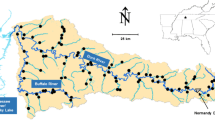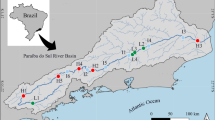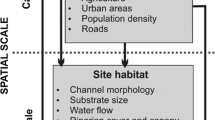Abstract
Context
Species dependent on freshwaters are declining globally. Understanding natural and anthropogenic environmental drivers affecting community structure and species occurrence is crucial for planning management and conservation actions.
Objectives
The aim of this study was to determine which landscape characteristics constrain reproductive guilds in wadeable streams and to explore the influence of reproductive strategy on fish occurrence. We expected reproductive guilds to differ in their associations with landscape determinants (i.e., the landscape characteristics found to constrain our reproductive guilds).
Methods
This study was conducted in the Delaware River Basin in North America. We compiled existing stream survey and geospatial data from multiple government agencies and scientific organizations for 552 sites. We used ordination and regression techniques to identify important landscape determinants and their associations with reproductive guilds.
Results
We identified 12 variables that explained 20.6% of the total variation in reproductive guild composition. Slope, land cover and disturbance variables drove the position of reproductive guilds in ordination space. All reproductive guilds differed in the set of landscape-scale determinants that were selected during modelling. Best subsets of variables selected in regression models indicate that reproductive guild occurrence is significantly explained by catchment characteristics. These characteristics include measures of slope, land use and land cover, disturbance, and climate.
Conclusions
Differences in determinants and relationships with reproductive guilds found in regression models, and gradients identified, indicate the importance of different landscape-scale determinants for specific reproductive guilds. Furthermore, our findings suggest a link between the environmental requirements of reproductive guilds and landscape-scale characteristics.


Similar content being viewed by others
References
Adams SB, Frissell CA, Rieman BE (2000) Movements of nonnative Brook Trout in relation to stream channel slope. Trans Am Fish Soc 129:623–638
Aguiar FC, Segurado P, Martins MJ, Bejarano MD, Nilsson C, Portela MM, Merritt DM (2018) The abundance and distribution of guilds of riparian woody plants change in response to land use and flow regulation. J Appl Ecol 55:2227–2240
Allen JD, Castillo MM (2007) Stream ecology structure and function of running waters, 2nd edn. Springer, Dordrecht
Balon EK (1975) Reproductive guilds of fishes: a proposal and definition. J Fish Res Board Can 32:821–864
Balon EK (1981) Additions and amendments to the classification and reproductive styles in fishes. Env Biol Fish 6:377–389
Barbour MT, Gerritsen J, Snyder BD, Stribling JB (1999) Rapid bioassessment protocols for use in streams and wadeable rivers: periphyton, benthic macroinvertebrates and fish, second edition. EPA 841-B-99-002. U.S. Environmental Protection Agency; Office of Water; Washington, DC
Daly C, Halbleib M, Smith JI, Gibson WP, Doggett MK, Taylor GH, Curtis J, Pasteris PA (2008) Physiographically-sensitive mapping of temperature and precipitation across the conterminous United States. Int J Climatol 28:2031–2064
Delaware River Basin Commission (2013) State of the Delaware River Basin 2013. West Trenton, NJ. http://www.state.nj.us/drbc/library/documents/SOTB/2013brochure.pdf. Accessed 26 Apr 2017
Dudgeon D, Arthington AH, Gessner MO, Kawabata Z-I, Knowler DJ, Leveque C, Naiman RJ, Prieur-Richard A-H, Soto D, Stiassny MLJ, Sullivan CA (2006) Freshwater biodiversity: importance, threats, status and conservation challenges. Biol Rev 81:163–182
Fullerton AH, Burnett KM, Steel EA, Flitcroft RL, Pess GR, Feist BE, Torgersen CE, Miller DJ, Sanderson BL (2010) Hydrological connectivity for riverine fish: measurement challenges and research opportunities. Freshw Biol 55:2215–2237
Gordon ND, McMahon TA, Finlayson BL (1992) Stream hydrology: an introduction for ecologists. Wiley, Chichester
Haag S, Shokoufandeh A (2019) Development of a data model to facilitate rapid watershed delineation. Environ Monit Softw 122:103973
Herlihy AT, Sifneos JC, Hughes JM, Peck DV, Mitchell RM (2019) Lotic fish assemblage clusters across the conterminous United States and their associations with environmental variables. In: Hughes RM, Infante DM, Wang L, Chen K, Terra BF (eds) Advances in understanding landscape influences on freshwater habitats and biological assemblages. American Fisheries Society, Symposium 90, Bethesda, Maryland, pp 385–408
Hill MO (1979) DECORANA: a FORTRAN program for detrended correspondence analysis and reciprocal averaging. Section of Ecology and Systematics, Cornell University, Ithaca
Hughes RM, Wang L, Seelbach PW (eds) (2006) Landscape influences on stream habitats and biological assemblages. American Fisheries Society, Symposium 48, Bethesda, Maryland
Hughes RM, Infante DM, Wang L, Chen K, Terra BF (eds) (2019) Advances in understanding landscape influences on freshwater habitats and biological assemblages. American Fisheries Society, Symposium 90, Bethesda, Maryland
Infante DM, Wang L, Hughes RM, Chen K, Terra BF (2019) Advancements, challenges, and gaps in understanding landscape influences on freshwater ecosystems. In: Hughes RM, Infante DM, Wang L, Chen K, Terra BF (eds) Advances in understanding landscape influences on freshwater habitats and biological assemblages. American Fisheries Society, Symposium 90, Bethesda, Maryland, pp 463–495
Jellyman PG, Harding JS (2012) The role of dams in altering freshwater fish communities in New Zealand. N Z J Mar Freshw Res 46:475–489
Johnson BL, Richardson WB, Naimo TJ (1995) Past, present, and future concepts in large river ecology. Bioscience 45:134–141
Kearny M (2006) Habitat, environment, and niche: what are we modelling? Oikos 115(1):186–191
Kornan M, Kropil R (2014) What are ecological guilds? Dilemma of guild concepts. Russ J Ecol 45(5):445–447
Kroll SA, Horwitz RJ, Keller DH, Sweeney BW, Jackson JK, Perez LB (2019) Large-scale protection and restoration programs aimed at protecting stream ecosystem integrity: the role of science-based goal setting, monitoring, and data management. Freshw Sci 38:23–39. https://doi.org/10.1086/701756
Liermann CR, Nilsson C, Robertson J, Ng RY (2012) Implications of dam obstruction for global freshwater fish diversity. Bioscience 62:539–548
Logan M (2010) Biostatistical design and analysis using R: a practical guide. Wiley-Blackwell, West Sussex
Macedo DR, Hughes RM, Ligeiro R, Ferreira WR, Castro M, Junqueira NT, Silva DRO, Firmiano KR, Kaufmann PR, Pompeu PS, Callisto M (2014) The relative influence of multiple spatial scale environmental predictors on fish and macroinvertebrate assemblage richness in Cerrado ecoregion streams, Brazil. Landsc Ecol 29:1001–1016
Malmqvist B, Rundle S (2002) Threats to the running water ecosystems of the world. Environ Conserv 29(2):134–153
Martin B, Tsang YP, Tingley RW III, Clilverd H, Infante DW (2019) Characterizing natural barriers to nonnative stream fauna in Hawai’i. In: Hughes RM, Infante DM, Wang L, Chen K, Terra BK (eds) Advances in understanding landscape influences on freshwater habitats and biological assemblages. American Fisheries Society, Symposium 90, Bethesda, Maryland, pp 83–104
McCormick FH, Hughes RM, Kaufmann PR, Peck DV, Stoddard JL, Herlihy AT (2001) Development of an index of biotic integrity for the Mid-Atlantic Highlands region. Trans Am Fish Soc 130:857–877
McManamay RA, Peoples BK, Orth DJ, Dolloff CA, Matthews DC (2015) Isolating causal pathways between flow and fish in the regulated river hierarchy. Can J Fish Aquat Sci 72:1731–1748
Melcher A, Schmutz S, Haidvogl G, Moder K (2007) Spatially based methods to assess the ecological status of European fish assemblage types. Fish Manag Ecol 14:453–463
Omernik JM, Griffith GE (2014) Ecoregions of the conterminous united states: evolution of a hierarchical spatial framework. Environ Manag 54:1249
Perkin JS, Troia MJ, Shaw DCR, Gerken JE, Gido KB (2014) Multiple watershed alterations influence fish community structure in Great Plains prairie streams. Ecol Freshw Fish 25:141–155
Perkin JS, Wellemeyer JC, Fore JD (2019) Multiscale fish assemblage distribution models to guide riverscape conservation planning. In: Hughes RM, Infante DM, Wang L, Chen K, Terra BF (eds) Advances in understanding landscape influences on freshwater habitats and biological assemblages. American Fisheries Society, Symposium 90, Bethesda, Maryland, pp 409–440
Pompeu PS, Leal CG, Carvalho DR, Junqueira NT, Castro MA, Hughes RM (2019) Effects of catchment land use on stream fish assemblage structure in the Brazilian savanna. In: Hughes RM, Infante DM, Wang W, Chen K, Terra BF (eds) Advances in understanding landscape influences on freshwater habitats and biological assemblages. American Fisheries Society, Symposium 90, Bethesda, Maryland, pp 303–320
Quinn GP, Keough M (2002) Experimental design and data analysis for biologists. Cambridge University Press, New York
Resh VH, Brown AV, Covich AP, Gurtz ME, Li HW, Minshall W, Reice SR, Sheldon AL, Wallace JB, Wissmar RC (1988) The role of disturbance in stream ecology. J N Am Benthol Soc 7:433–455
R Core Team (2017) R: a language and environment for statistical computing. R Foundation for Statistical Computing, Vienna
Sály P, Takács P, Kiss I, Bíró P, Erös T (2011) The relative influence of spatial context and catchment- and site-scale environmental factors on stream fish assemblages in a human-modified landscape. Ecol Freshw Fish 20:251–262
Simon TP (1999) Assessment of Balon’s reproductive guilds with application to midwestern North American freshwater fishes. In: Simon TP (ed) Assessing the sustainability and biological integrity of water resources using fish communities. CRC Press, Boca Raton, pp 97–121
Stauffer JR, Criswell RW, Fischer DP (2016) The fishes of Pennsylvania. Cichlid Press, Lauenau, p 556
Southwood TRE (1988) Tactics, strategies, templets. Oikos 52:3–18
ter Braak CJF, Smilauer P (2012) Canoco reference manual and user’s guide: software for ordination (version 5.0). Microcomputer Power, Ithaca, p 496
Thornbrugh DJ, Infante DM (2019) Landscape effects on stream fishes: broad-scale responses to anthropogenic land use across temperate mesic regions of the United States. In: Hughes RM, Infante DM, Wang L, Chen K, Terra BF (eds) Advances in understanding landscape influences on freshwater habitats and biological assemblages. American Fisheries Society, Symposium 90, Bethesda, Maryland, pp 351–383
Townsend CR, Crowl TA (1991) Fragmented population structure in a native New Zealand fish: an effect of introduced brown trout? Oikos 61:347–354
Townsend CR, Hildrew AG (1994) Species traits in relation to a habitat templet for river system. Freshw Biol 31:265–276
Walsh C, Mac Nally R (2013) hier.part: hierarchical Partitioning. R package version 1.0–4. https://CRAN.R-project.org/package=hier.part
Ward JV, Stanford JA (1983) The serial discontinuity concept of lotic ecosystems. Dyn Lotic Ecosyst 10:29–42
Young RG, Quarterman AJ, Eyles RF, Smith RA, Bowden WB (2005) Water quality and thermal regime of the Motueka River: influences of land cover, geology and position in the catchment. N Z J Mar Freshw Res 39(4):803–882
Acknowledgements
Thank you Jim Kurtenbach of the US Environmental Protection Agency, Mari-Beth DeLucia of The Nature Conservancy, Jason Cruz, Lance Butler, Joe Perillo, and Raymond Pierdomenico of the Philadelphia Water Department, Douglas Fischer of the Pennsylvania Fish and Boat Commission, and Brian Duffy and Alexander J. Smith of the New York State Department of Environmental Conservation for providing data.
Author information
Authors and Affiliations
Corresponding author
Additional information
Publisher's Note
Springer Nature remains neutral with regard to jurisdictional claims in published maps and institutional affiliations.
Supplementary information
Below is the link to the electronic supplementary material.
Rights and permissions
About this article
Cite this article
Keller, D.H., Barren, G.J. & Horwitz, R.J. Landscape determinants of fish reproductive guilds. Landscape Ecol 36, 845–862 (2021). https://doi.org/10.1007/s10980-020-01183-6
Received:
Accepted:
Published:
Issue Date:
DOI: https://doi.org/10.1007/s10980-020-01183-6




